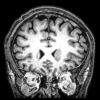Anxiogenic-like effects of chronic cannabidiol administration in rats.
Several pre-clinical and human-based studies have shown that acutely administered cannabidiol (CBD) can produce anxiolytic-like effects
The present study investigated the effects of chronic administration of CBD on rat behaviour and on the expression of brain proteins.
Male Lister-hooded rats (150-200 g, n = 8 per group) received daily injections of CBD (10 mg/kg, i.p.) for 14 days. The rats were subjected to two behavioural tests: locomotor activity and conditioned emotional response (CER). The expression of brain-derived neurotrophic factor (BDNF), its receptor tyrosine kinase B (Trk B), extracellular signal-regulated kinases (ERK1/2) and phospho-ERK1/2 and the transcription factor cyclic AMP response element binding protein activation (CREB) and phospho-CREB were determined in brain regions such as the frontal cortex and hippocampus using Western immunoblotting.
CBD significantly increased the time spent freezing in the CER test with no effect on locomotor activity. CBD significantly reduced BDNF expression in the hippocampus and frontal cortex with no change in the striatum. In addition, CBD significantly reduced TrkB expression in the hippocampus with a strong trend towards reduction in the striatum but had no effect in the frontal cortex. In the hippocampus, CBD had no effect on ERK1/2 or phospho-ERK2, but in the frontal cortex, CBD significantly reduced phospho-ERK1/2 expression without affecting total ERK. Chronic administration of CBD produced an anxiogenic-like effect in clear opposition to the acute anxiolytic profile previously reported. In addition, CBD decreased the expression of proteins that have been shown to be enhanced by chronic treatment with antidepressant/anxiolytic drugs.
Cannabidiol is a negative allosteric modulator of the type 1 cannabinoid receptor.
Cannabidiol has been reported to act as an antagonist of cannabinoid agonists at type 1 cannabinoid receptors (CB1 ). We hypothesized that cannabidiol can inhibit cannabinoid agonist activity through negative allosteric modulation of CB1 .
CB1 internalization, arrestin2 recruitment, and PLCβ3 and ERK1/2 phosphorylation, were quantified in HEK 293A cells heterologously expressing CB1 and in the STHdhQ7/Q7 cell model of striatal neurons endogenously expressing CB1 . Cells were treated with 2-arachidonylglycerol or Δ9 -tetrahydrocannabinol alone and in combination with different concentrations of cannabidiol.
Cannabidiol reduced the efficacy and potency of 2-arachidonylglycerol and Δ9 -tetrahydrocannabinol on PLCβ3- and ERK1/2-dependent signaling in cells heterologously (HEK 293A) or endogenously (STHdhQ7/Q7 ) expressing CB1 . By reducing arrestin2 recruitment to CB1 , cannabidiol treatment prevented CB1 internalization. The allosteric activity of cannabidiol depended upon polar residues being present at positions 98 and 107 in the extracellular amino-terminus.
Cannabidiol behaved as a non-competitive negative allosteric modulator of CB1 . Allosteric modulation, in conjunction with non-CB1 effects, may explain the in vivo effects of cannabidiol. Allosteric modulators of CB1 have the potential to treat central nervous system and peripheral disorders while avoiding the adverse effects associated with orthosteric agonism or antagonism of CB1 . This article is protected by copyright. All rights reserved.
Potential anxiogenic effects of cannabinoid CB1 receptor antagonists/inverse agonists in rats: comparisons between AM4113, AM251, and the benzodiazepine inverse agonist FG-7142.
Cannabinoid CB1 inverse agonists suppress food-motivated behaviors, but may also induce psychiatric effects such as depression and anxiety. To evaluate behaviors potentially related to anxiety, the present experiments assessed the CB1 inverse agonist AM251 (2.0-8.0mg/kg), the CB1 antagonist AM4113 (3.0-12.0mg/kg), and the benzodiazepine inverse agonist FG-7142 (10.0-20.0mg/kg), using the open field test and the elevated plus maze. Although all three drugs affected open field behavior, these effects were largely due to actions on locomotion. In the elevated plus maze, FG-7142 and AM251 both produced anxiogenic effects. FG-7142 and AM251 also significantly increased c-Fos activity in the amygdala and nucleus accumbens shell. In contrast, AM4113 failed to affect performance in the plus maze, and did not induce c-Fos immunoreactivity. The weak effects of AM4113 are consistent with biochemical data showing that AM4113 induces little or no intrinsic cellular activity. This research may lead to the development of novel appetite suppressants with reduced anxiogenic effects.
Agonistic properties of cannabidiol at 5-HT1a receptors.
Cannabidiol (CBD) is a major, biologically active, but psycho-inactive component of cannabis. In this cell culture-based report, CBD is shown to displace the agonist, [3H]8-OH-DPAT from the cloned human 5-HT1a receptor in a concentration-dependent manner. In contrast, the major psychoactive component of cannabis, tetrahydrocannabinol (THC) does not displace agonist from the receptor in the same micromolar concentration range. In signal transduction studies, CBD acts as an agonist at the human 5-HT1a receptor as demonstrated in two related approaches. First, CBD increases [35S]GTPgammaS binding in this G protein coupled receptor system, as does the known agonist serotonin. Second, in this GPCR system, that is negatively coupled to cAMP production, both CBD and 5-HT decrease cAMP concentration at similar apparent levels of receptor occupancy, based upon displacement data. Preliminary comparative data is also presented from the cloned rat 5-HT2a receptor suggesting that CBD is active, but less so, relative to the human 5-HT1a receptor, in binding analyses. Overall, these studies demonstrate that CBD is a modest affinity agonist at the human 5-HT1a receptor. Additional work is required to compare CBD's potential at other serotonin receptors and in other species. Finally, the results indicate that cannabidiol may have interesting and useful potential beyond the realm of cannabinoid receptors.
Decreased brain serotonin 5-HT1A receptor availability in medication-naive patients with major depressive disorder: an in-vivo imaging study using PET and [carbonyl-11C]WA Y-100635
Serotonin (5-HT) is involved in the pathophysiology of major depressive disorder (MDD). Among the numerous serotonergic receptors, the 5-HT1A receptor subtype is of interest because of its involvement in cognition, hippocampal neurogenesis, and mechanism of action of antidepressant drugs. Previous imaging studies have suggested altered availability of 5-HT1A receptors in MDD but prior antidepressant medication and chronicity of the illness may confound the interpretation. We examined 21 drug-naive primary-care patients with MDD using positron emission tomography (PET) imaging with [carbonyl-11C]WAY-100635, a radioligand for 5-HT1A receptors, along with 15 healthy control subjects. Binding to receptors was assessed both regionally and at voxel level with the binding potential (BP) that was estimated using arterial blood input. Compared with healthy controls, the BP of [carbonyl-11C]WAY-100635 was reduced in patients with MDD in most brain regions, ranging from −9% to −25%. Voxel-level analysis confirmed this finding by showing a widespread reduction of [carbonyl-11C]WAY-100635 BP. No statistically significant associations were observed between BP and total HAMD scores in the patients, but lower BP was associated with higher likelihood of insomnia. This study demonstrated a widespread reduction in the availability of serotonin 5-HT1A receptors in a relatively large sample of drug-naive primary-care patients with MDD, suggesting the involvement of this receptor subtype in the pathophysiology of the illness. Lack of correlation with overall severity of the illness may relate to a largely trait-like nature of this abnormality in depressive disorders.
The orphan receptor GPR55 is a novel cannabinoid receptor
The endocannabinoid system functions through two well characterized receptor systems, the CB1 and CB2 receptors. Work by a number of groups in recent years has provided evidence that the system is more complicated and additional receptor types should exist to explain ligand activity in a number of physiological processes.
Cells transfected with the human cDNA for GPR55 were tested for their ability to bind and to mediate GTPγS binding by cannabinoid ligands. Using an antibody and peptide blocking approach, the nature of the G-protein coupling was determined and further demonstrated by measuring activity of downstream signalling pathways.
We demonstrate that GPR55 binds to and is activated by the cannabinoid ligand CP55940. In addition endocannabinoids including anandamide and virodhamine activate GTPγS binding via GPR55 with nM potencies. Ligands such as cannabidiol and abnormal cannabidiol which exhibit no CB1or CB2 activity and are believed to function at a novel cannabinoid receptor, also showed activity at GPR55. GPR55 couples to Gα13 and can mediate activation of rhoA, cdc42 and rac1.
These data suggest that GPR55 is a novel cannabinoid receptor, and its ligand profile with respect to CB1 and CB2 described here will permit delineation of its physiological function(s).
... both anandamide and O1602 but not WIN55,212-2 treatment induced the activation of rhoA, cdc42 and rac1. This effect was blocked by the GPR55 antagonist, cannabidiol.
Blockade of GPR55 in the dorsolateral striatum impairs performance of rats in a T-maze paradigm.
To investigate the role of GPR55 receptors, which are expressed in human and rat striatum (a structure that regulates procedural memory), Wistar rats received five training sessions (10 trials/session, 1 session/day) to solve a T-maze paradigm. From these data, we constructed learning curves following pharmacological manipulation of GPR55. Five minutes before each session, animals received bilateral intradorsolateral striatum injections of noladin-ether (3.1 nmol/l; endogenous agonist of GPR55 and CB1 receptors), CID16020036 (5.6 nmol/l; GPR55 antagonist), AM251 (5.6 nmol/l; CB1 antagonist), or a combination of noladin-ether with each antagonist. Noladin-ether by itself induced no significant changes in the learning curve. Nevertheless, while simultaneously blocking CB1 receptors (with AM251), noladin-ether improved acquisition. In contrast, while simultaneously blocking GPR55 (with CID16020036), noladin-ether weakened acquisition. CID16020036 by itself impaired learning, whereas AM251 by itself reduced the efficiency in the task. There were no differences between groups in the latency to reach the arms from the starting point; thus, no motor coordination impairments interfered with this task. These results strongly suggest a role of GPR55 in procedural memory and constitute the first evidence indicating that this receptor regulates cognitive processes.
Cannabidiol is a allosteric modulator at mu- and delta-opioid receptors.
The mechanism of action of cannabidiol, one of the major constituents of cannabis, is not well understood but a noncompetitive interaction with mu opioid receptors has been suggested on the basis of saturation binding experiments. The aim of the present study was to examine whether cannabidiol is an allosteric modulator at this receptor, using kinetic binding studies, which are particularly sensitive for the measurement of allosteric interactions at G protein-coupled receptors. In addition, we studied whether such a mechanism also extends to the delta opioid receptor. For comparison, (-)-Delta9-tetrahydrocannabinol (THC; another major constituent of cannabis) and rimonabant (a cannabinoid CB1 receptor antagonist) were studied. In mu opioid receptor binding studies on rat cerebral cortex membrane homogenates, the agonist 3H-DAMGO bound to a homogeneous class of binding sites with a KD of 0.68+/-0.02 nM and a Bmax of 203+/-7 fmol/mg protein. The dissociation of 3H-DAMGO induced by naloxone 10 microM (half life time of 7+/-1 min) was accelerated by cannabidiol and THC (at 100 microM, each) by a factor of 12 and 2, respectively. The respective pEC50 values for a half-maximum elevation of the dissociation rate constant k(off) were 4.38 and 4.67; 3H-DAMGO dissociation was not affected by rimonabant 10 microM. In delta opioid receptor binding studies on rat cerebral cortex membrane homogenates, the antagonist 3H-naltrindole bound to a homogeneous class of binding sites with a KD of 0.24+/-0.02 nM and a Bmax of 352+/-22 fmol/mg protein. The dissociation of 3H-naltrindole induced by naltrindole 10 microM (half life time of 119+/-3 min) was accelerated by cannabidiol and THC (at 100 microM, each) by a factor of 2, each. The respective pEC50 values were 4.10 and 5.00; 3H-naltrindole dissociation was not affected by rimonabant 10 microM. The present study shows that cannabidiol is a NEGATIVE (see attached pdf) allosteric modulator at mu and delta opioid receptors. This property is shared by THC but not by rimonabant.





























































